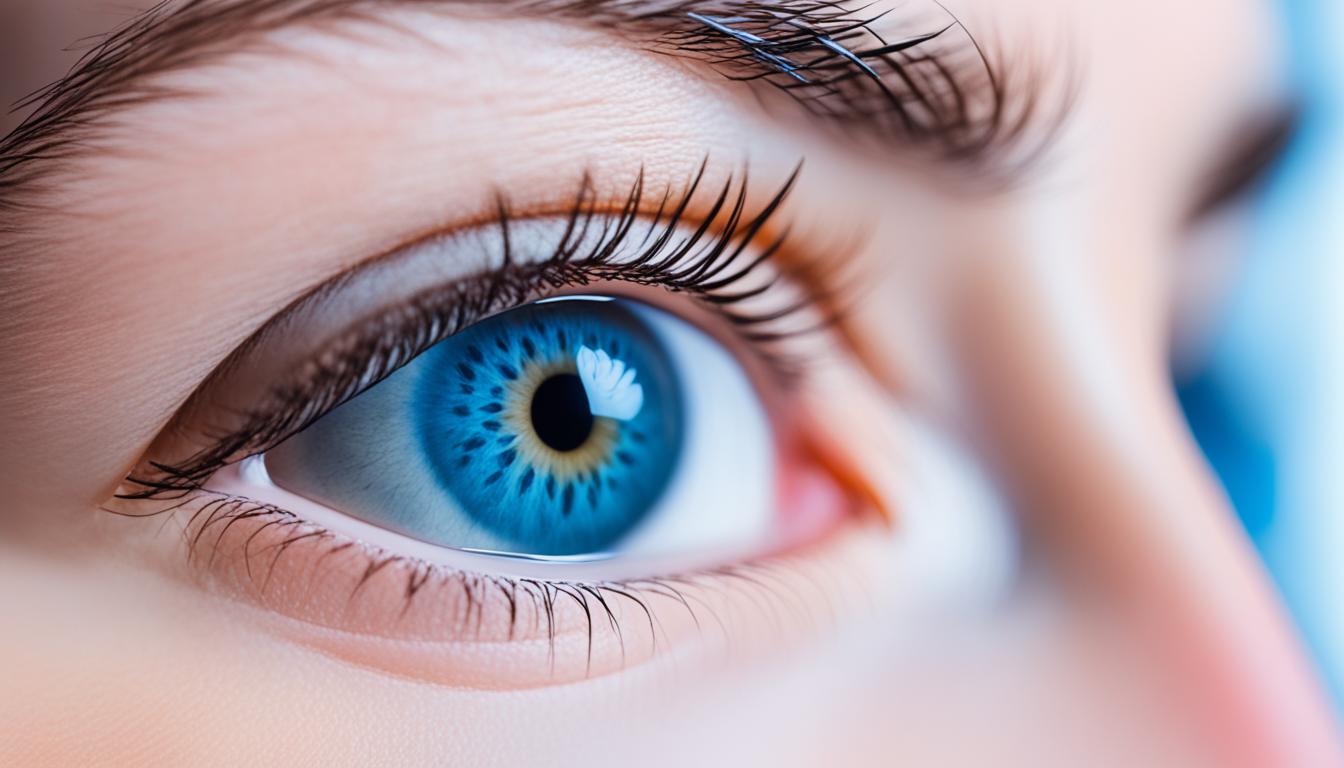Entropion makes the lower eyelid curl in. This makes the eyelashes touch the eye, leading to pain, redness, and more. It can make eyes sensitive to light and vision worse. Both adults and kids can get entropion, but the reasons differ.
For adults, entropion often comes with aging. As you get older, fat around the eyes decreases. This weakens the eyelid, making it fold in. Kids can be born with entropion. It’s because their eyelid structure is different from usual.
Many things can cause entropion, like birth defects and eye muscle weakness. Infections and scarring are also culprits. It’s important to see a doctor if you have symptoms.
The type of treatment for entropion depends on how bad it is. Mild cases might just need eye drops. But, serious cases might need surgery. Stem cell therapy is a new approach to help fix the problem.
Key Takeaways:
- Entropion makes the lower eyelid turn in, causing problems.
- Old age or being born that way can lead to entropion.
- Symptoms include red eyes, pain, light sensitivity, and bad vision.
- Birth issues, weak muscles, and infections can cause this eye problem.
- Treatments range from drops to surgery or even stem cell therapy.
Causes and Risk Factors of Entropion
Entropion makes the eyelid margin turn inward, causing pain and possible eye damage. It’s important to know what causes and raises risks of entropion. This helps in treating and stopping it.
Several things can make entropion more likely to happen:
Congenital Defects
In newborns, structural problems in the eye’s support cartilage can make the eyelid turn in. This causes the eye to feel sore and uncomfortable.
Age and Loss of Orbital Fat
Getting older can lead to entropion. Over time, we can lose the fat around our eyes, making the eyelid flip inward. This change as we age is a key reason for entropion.
Eye Infections and Inflammation
Infections, like trachoma, can also cause entropion. Trachoma is an infection that can scar the eyelids. These scars can make the eyelid turn in.
Squint, Spasm, and Scarring
Squinting, muscle spasms, and even past eye surgeries can result in entropion. These actions can mess up how the eyelids sit, causing them to curl in.
Developmental Complications
Problems during birth can also lead to entropion. Certain genes and things around us as we grow in the womb can affect how our eyelids form. This can make them turn inward.
Knowing the following can make us more aware of entropion risks:
- Getting older often leads to more chances of entropion.
- An eye injury can disrupt the eyelids’ normal place, causing entropion.
- Some health issues, like trachoma, can also up the risk of entropion.
Treating entropion starts with dealing with its root cause:
- In some cases, medicated eye drops or ointments can reduce inflammation and help.
- Lubricating eye drops can make the eye feel less dry and painful.
- If it’s severe, entropion might need surgery to fix the eyelid’s position. Surgery aims to re-align the eyelid edge and protect the eye.
Detecting and managing with entropion’s causes and risks can help people get the right care. This can reduce the harm entropion causes to their eyes.
Diagnosis and Management of Entropion
Diagnosing entropion means checking your eyes carefully and asking about your symptoms. Doctors look for signs like redness, irritation, and eyelids that turn in. They might also run tests to check how much the cornea has been hurt. This might include tests on tears and using special dyes.
If the entropion is mild, treatment might not need surgery. Things like special eye drops or ointments can help. They make your eye more comfortable and cut down on the problem of your eyelid rubbing against your eye.
More serious entropion cases may need surgery. There are different types of surgeries. Some involve making the eyelid shorter, fixing muscles, or correcting other problems in the eyelid. This helps the eyelid work the right way again.
Surgical Options for Entropion Treatment
| Surgical Option | Description |
|---|---|
| Eyelid Shortening | Excision of a small segment of the eyelid to reduce its length and restore normal lid tension. |
| Muscle Reattachment | Repositioning and tightening of the eyelid muscles to prevent the inward folding and maintain proper lid position. |
| Correction of Underlying Structural Defects | Repairing any structural abnormalities in the eyelid or surrounding tissues that may contribute to entropion. |
These surgeries should be done by experts in eye surgery or plastic surgery. They can provide lasting relief and make life better for people with entropion.
It’s important to see a doctor for the best care. They can make a treatment plan that’s just right for you, depending on what you need.
Stem Cell Therapy for Entropion
Stem cell therapy is a modern way to treat entropion. It uses the power of stem cells to fix eyelid damage. Stem cells can turn into the types of cells needed to heal the lids.
Early research shows stem cell therapy is promising for fixing eyelid issues. It may help adjust the eyelids back to normal and reduce entropion symptoms. Remember, only trained doctors should do this procedure.
For those not able to have regular surgery or have tried other treatments without success, stem cell therapy could be an option. But because it’s a new method, always talk to a specialist to see if it might work for you.

